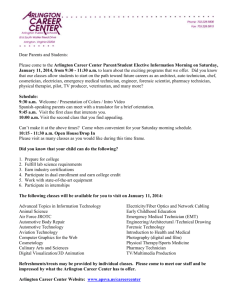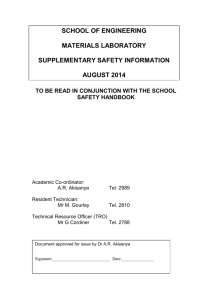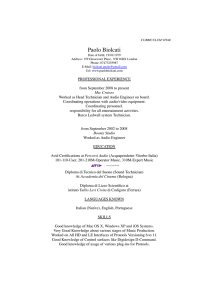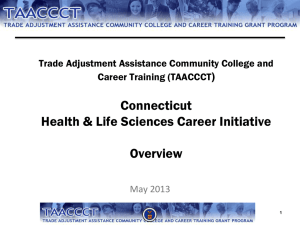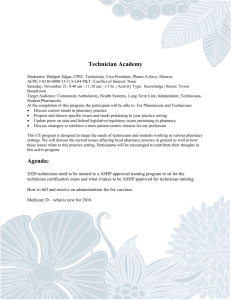DEPARTMENT OF ENGINEERING
advertisement
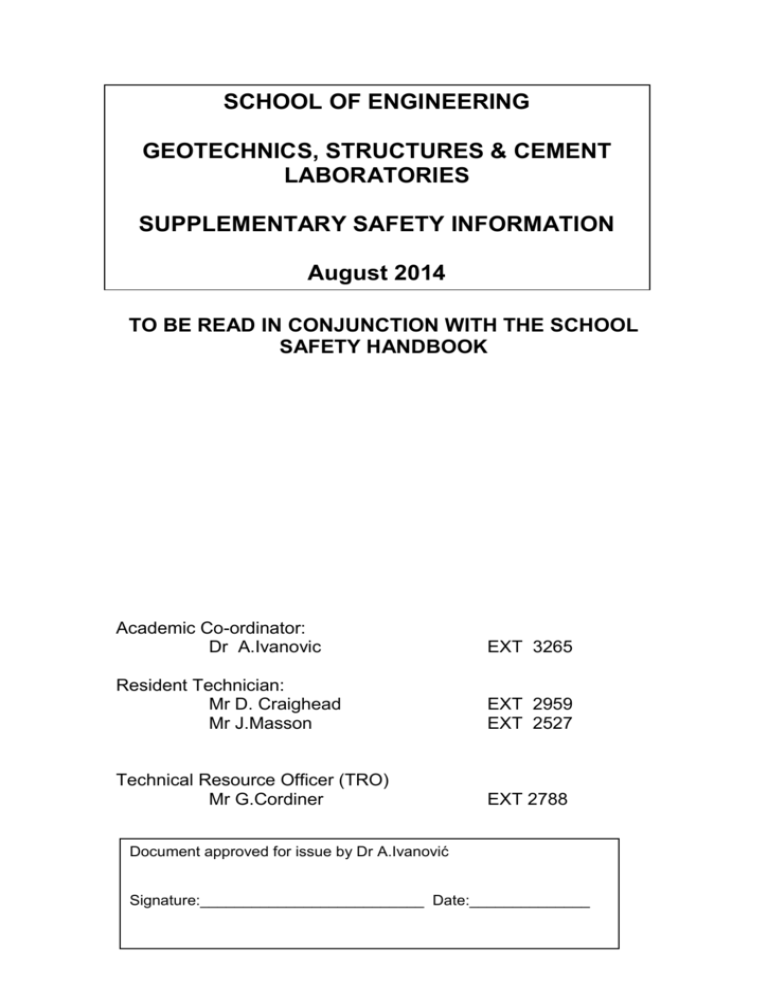
SCHOOL OF ENGINEERING GEOTECHNICS, STRUCTURES & CEMENT LABORATORIES SUPPLEMENTARY SAFETY INFORMATION August 2014 TO BE READ IN CONJUNCTION WITH THE SCHOOL SAFETY HANDBOOK Academic Co-ordinator: Dr A.Ivanovic EXT 3265 Resident Technician: Mr D. Craighead Mr J.Masson EXT 2959 EXT 2527 Technical Resource Officer (TRO) Mr G.Cordiner EXT 2788 Document approved for issue by Dr A.Ivanović Signature:__________________________ Date:______________ CONTENTS 1. TRAINING & RISK ASSESSMENT 2. ELECTRICITY 3. MANUAL HANDLING 4. OVERHEAD CRANES 5. DANGEROUS MOVING PARTS 6. CONCRETE TESTING APPARATUS 7. CEMENT MIXING MACHINES 8. CEMENT, CONCRETE DUST AND CHEMICALS 9. COMPRESSED AIR 10. SLIPS AND TRIPS 11. HAND TOOLS 12. GEOTECHNICS APPARATUS TRAINING & RISK ASSESSMENT All persons commencing work in the lab must undergo a formal Laboratory Induction in addition to the Basic Induction they received on arrival at the School. In addition to records of induction training, records must also be kept of any further training provided. No work should commence in the lab until a risk assessment has been completed in conformance with School procedures as stated in the School Safety Handbook. ELECTRICITY The Estates Section are responsible for the provision and maintenance of a safe electrical supply. When undertaking maintenance work on electrically powered equipment, the power supply should either be isolated and padlocked off or, in the case of 13Amp plugs, plugs should be removed from their sockets and the plug and cable returned to the equipment. No electrical equipment should be opened without permission of a supervisor and without having the necessary experience. MANUAL HANDLING Whenever possible, mechanical lifting devices should be used to move concrete and equipment in the Lab. Rollertrucks, trolleys and the high stacker must be kept in good condition and maintained regularly. Lifting equipment, shackles and slings should be entered on the School’s Lifting Register and inspected by the University Insurance inspector at proscribed intervals. In the case of lifting equipment this is annual and for lifting accessories the interval is 6 months. The TRO is responsible for making sure all this happens and that records are kept. OVERHEAD CRANES Each lab contains an electrically powered overhead crane. Due to the low ceiling height the electrical power to the cranes is carried on electrical busbars within arms reach. As part of the laboratory refurbishment completed in 2009 the bus bars were upgraded and enclosed to ensure that no accidental contact can occur. However, no persons should attempt to poke anything into them as contact with the conductors within the bus-bars will result in death or serious injury. The electrical power to the crane under normal conditions is locked off and under the control of the Resident Technician. Only the laboratory technician is permitted to operate the overhead cranes. The crane must be maintained in accordance with manufacturers instructions and be entered on the School’s Lifting Register and inspected by the University insurance inspector annually. The TRO is responsible for making sure all this happens and that records are kept. DANGEROUS MOVING PARTS The lab uses equipment with potentially dangerous moving parts. When working with equipment with dangerous moving parts the equipment must be adequately guarded to prevent accidental contact to the experimenter or any other persons having business in the lab. The type of guarding provided for the lab is in the form of floor standing mobile screens. The screen should be positioned such that the operator or any other lab users cannot accidentally come in to contact with moving parts. The operator and equipment requiring access during experiments will be positioned on the safe side of the screen. When setting up or adjusting electrically powered equipment with dangerous moving parts, the power supply should either be isolated and padlocked off or, in the case of 13Amp plugs, plugs should be removed from their sockets and the plug and cable returned to the equipment. No equipment should be operated without the express permission of Lab Coordinator or the Resident Technician and only after training. CONCRETE TESTING APPARATUS The lab contains large equipment used in compression testing of concrete. The equipment is generally electrically powered often requiring hydraulic supplies. No operation of equipment is permitted without the express permission of the Lab Co-ordinator or Resident Technician and until after obtaining training. The technician will normally oversee testing operations within the lab. The compression testing of concrete creates very high pressures up to a maximum of 3000KN. The use of screens is required to protect personnel from accidental contact with machinery. The testing equipment is maintained by the Resident Technician. It is the responsibility of the Lab Co-ordinator/TRO to ensure this happens and to keep records. CEMENT MIXING MACHINES Machines used to mix concrete are electrically powered. Lab users must receive the express permission of the Lab Co-ordinator or the Resident Technician prior to use and receive adequate training normally from the Resident Technician. The technician will also supervise the operations. When operating the mixer suitable protective equipment must be used including safety glasses, dust masks and gloves. Other users in the lab must also be provided with protective equipment for example dust masks. CEMENT, CONCRETE DUST AND CHEMICALS Working with cement requires that precautions are taken to avoid respiratory or skin problems. Anyone working with cement or concrete dust must wear suitable dust masks to a minimum of FFP2 (adequate filtering of dust particles) which must properly fit the face. Cement can also cause skin conditions such as dermatitis therefore contact with the skin should be prevented by the use of suitable protective equipment. Suitable equipment includes lab coat or boiler suit, full face mask, dust mask and gloves. Rigger gloves can be used for dry work while wet work requires gloves to be heavy duty PVC or nitrile. Suitable protective equipment is available from the Resident Technician or the TRO. If you discover a change in skin condition you are advised to seek medical advice. You should also report this to either your supervisor, the safety advisor or anyone listed on the front of this document who will contact the University Safety Advisor who may recommend monitoring the condition. You the University Safety Officer can also be contacted directly, if necessary. An HSE publication INDG233(rev1) March 2007 “Preventing Contact Dermatitis at Work” is available to read in the lab or available from the TRO. A list of chemicals and their safety data sheets must be kept up to date and filed in the appropriate folder. Solvents and acids must be stored in separate cabinets. Chemicals used in both maintenance and experimental work must be addressed in the Risk Assessment. INSTRON Testing Machine The lab contains an INSTRON 8500 testing machine for static and dynamic loading of structures. This is computer controlled and hydraulically powered. Operation of this equipment is permitted only with the express permission of the Lab Co-ordinator and only after obtaining training and should be used in accordance with the manual (M11-98500-10; Issue B January 1995). Normally the Resident Technician will operate the INSTRON test machine, however he/she will always oversee testing operations using this machine within the lab. The INSTRON can create forces up to a maximum of 500KN and can move rapidly. The use of screens is required to protect personnel from accidental contact with machinery. Accidental activation of the machine is precluded as the hydraulic power pack and associated switch are in a locked cupboard remote from the machine. The testing equipment is maintained by the Resident Technician. It is the responsibility of the Lab Coordinator/TRO to ensure this happens and to keep records. COMPRESSED AIR Some machines and equipment require a compressed air supply for normal operation. The Resident Technician will make any connections to machines requiring compressed air. Compressed air may also be used for cleaning parts or inaccessible areas. Never direct compressed air at anyone. It has been known for people to be killed by misuse of compressed air. SLIPS AND TRIPS The main walkways should be kept clear of objects and there should be no trailing cables. If it is absolutely necessary to have trailing cables, they should be covered with a suitable ramp or rubber cable protector. Oil spills should be cleared immediately. HAND TOOLS Hand tools must be maintained in good condition. Safety goggles, helmets, footwear and gloves must be used when necessary. GEOTECHNICS APPARATUS The lab contains standard equipment used for obtaining soil properties. The equipment is generally electrically powered often requiring water supplies. All taps should be closed after the completion of a test. No operation of equipment is permitted without the express permission of the Lab Coordinator or Resident Technician and until after obtaining training. The technician will normally oversee testing operations within the lab. The GDS system can create high water pressures which, and if used is computer controlled by the machine. The computer accompanying this system cannot be powered without the provision of a key and the permission of the Resident Technician. Dust masks should be worn when a soil sample is being prepared for a shear box test. The procedures for the projects currently undertaken in the lab are situated in the plastic boxes fixed on the wall in close proximity of the testing rig space. The following points must be adhered to by all users:The guard must be in position at all times. Eye protection must be worn. Beware of loose clothing. No jewellery or bandages, and gloves must not be worn. Long hair must be tied back.
